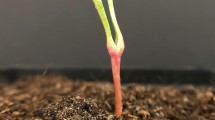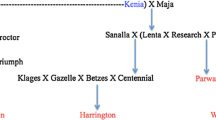Summary
Monosomic additions of Beta vulgaris x B. procumbens with resistance to beet cyst nematode (Heterodera schachtii Schm.) were used for the production of resistant diploids through incorporation of the B. procumbens chromosome fragment bearing the resistance gene(s) into one of the sugar beet chromosomes. The heterozygotes obtained accordingly were selfed for producing homozygotes. These homozygotes differed morphologically from commercial sugar beet varieties, but produced reasonable amounts of pollen. Female transmission of resistance was 100%, whereas male transmission, apart from some exceptions, was more than 90%. The number of hypersensitivity reactions to penetrated larvae was related to the degree of susceptibility. Larval development was severely retarded in the resistant plants, preventing most of them to produce cysts. If cysts were formed, their content was considerably less as compared to those in the susceptible plants.
Similar content being viewed by others
References
Bergman B.H.H., 1958. Sugar beet eelworm and its control. V. Some microscopic observations on the development of larvae of Heterodera schachtii in the roots of susceptible and resistant plants. Meded Inst Rationele suikerprod 28: 149–169.
De Jong J.H. & T.S.M.de Bock, 1978. Use of haploids of Beta vulgaris L. for the study of orcein and Giemsa stained chromosomes. Euphytica 27: 41–47.
De Jong, J.H., W. Heijbroek & B. Mans, 1981. Identification of the alien chromosome in cyst nematode resistant trisomics of Beta vulgaris x B. procumbens. In: Investigation into chromosome morphology of sugar beet and related wild species. Ph.D. Thesis, University of Amsterdam, The Netherlands.
De Jong J.H. & P. Stam, 1985. The association of centromeres of nonhomologous chromosomes at meiotic prophase in Beta vulgaris L.. Can J Genet Cytol 27: 165–171.
De Jong J.H., G.J. Speckmann, Th.S.M.de Bock & A.van Voorst, 1985. Monosomic additions with resistance to Beet Cyst Nematode obtained from hybrids of Beta vulgaris and wild Beta species of the section Patellares. II. Comparative analysis of the alien chromosome. Z Pflanzenzüchtg 95: 84–94.
De Jong J.H., G.J. Speckmann, Th.S.M.de Bock, W. Lange & Avan Voorst, 1986. Alien chromosome fragments conditioning resistance to beet cyst nematode in diploid descendants from monosomic additions of Beta procumbens to Beta vulgaris. Can J Genet Cytol 28: 439–443.
Heijbroek, W., 1979. Results of the sugar beet nematode enquiry, organised by the Pests and Diseases Study Group of the IIRB. Proc. 42nd IIRB Winter Congress: 141–147.
Heijbroek W., J.S.M. McFarlane & D.L. Doney, 1977. Breeding for tolerance to beet cyst eelworm Heterodera schachtii Schm. in sugar beet. Euphytica 26: 557–564.
Heijbroek W., A.J. Roelands & J.H.de Jong, 1983. Transfer of resistance to beet cyst nematode from Beta patellaris to sugar beet. Euphytica 32: 287–298.
Müller J. & W. Steudel, 1983. Der Einfluss der Kulturdauer verschiedener Zwischenfrüchte auf die Abundanzdynamik von Heterodera schachtii. Nachrichtenbl Deut Pflanzenschutzd 35: 103–108.
Savitsky H., 1973. Meiosis in hybrids between Beta vulgaris L. and transmission of sugar beet nematode resistance. Genetics 74: 241 (Supplement).
Savitsky H., 1975. Hybridization between Beta vulgaris and B. procumbens and transmission of nematode (Heterodera schachtii) resistance to sugar beet. Can J Genet Cytol 17: 197–209.
Snow R., 1963. Alcoholic hydrochloric acid carmine as a stain for chromosomes in squash preparations. Stain Technol 38: 9–13.
Speckmann G.J., Th.S.M.de Bock & J.H.de Jong, 1985. Monosomic additions with resistance to Beet Cyst Nematode obtained from hybrids of Beta vulgaris and wild Beta species of the section Patellares. I. Morphology, Transmission and level of resistance. Z Pflanzenzüchtg 95: 74–83.
Toxopeus, J.H. & H. Lubberts, 1970. Breeding for resistance to the sugar beet nematode (Heterodera schachtii Schm.) in Cruciferous crops. Proc. Eucarpia Cruciferae Conference, Wageningen: 151.
Yu m.H. & A.E.S. Steele, 1981. Host-parasite interaction of resistant sugarbeet and Heterodera schachtii. J Nematol 13: 206–212.
Author information
Authors and Affiliations
Rights and permissions
About this article
Cite this article
Heijbroek, W., Roelands, A.J., de Jong, J.H. et al. Sugar beets homozygous for resistance to beet cyst nematode (Heterodera schachtii Schm.), developed from monosomic additions of Beta procumbens to B. vulgaris . Euphytica 38, 121–131 (1988). https://doi.org/10.1007/BF00040182
Received:
Accepted:
Issue Date:
DOI: https://doi.org/10.1007/BF00040182




